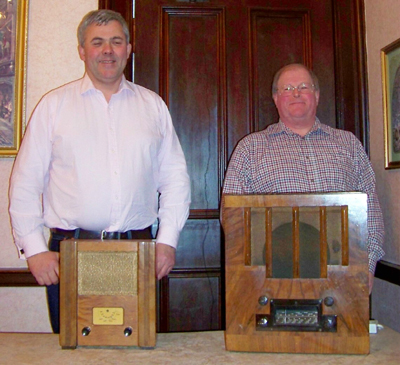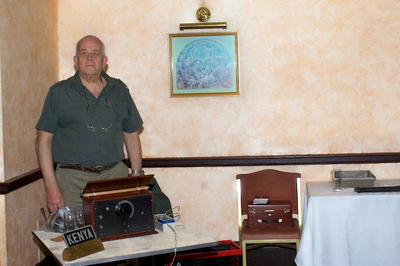- Details
- Written by Alan GM3PSP
- Hits: 3801
Geoff Crowley MM5AHO returned to the LRS on January 25th to describe and show video footage shot by his son Matt MM1EUI of their participation in the International Lighthouses and Lightships Weekend in August 2011. They sailed from Oban to Skerryvore, Dubh Artach and several other lighthouse. While there they did exploration and research into the building of these Stevenson lighthouses. The presentation covered the construction of the Skerryvore and Dubh Artach lighthouses, radio operations while anchored alongside various lights on Scotland's west coast, yachting and wildlife seen on the 300 mile journey.
Photographs courtesy of Geoff MM5AHO.

Geoff made a welcome return to the LRS to describe his 2011 lighthouses cruise.
Read more: 25 Jan 2012 - International Lighthouses & Lightships Weekend 2011 by Geoff Crowley MM5AHO
- Details
- Written by Alan GM3PSP
- Hits: 3995
Report and photographs by Peter Dick GM4DTH.

Dr. David Gavine talking at the LRS meeting.
At the LRS meeting on 8th February 2012 Dr David Gavine gave a most interesting talk "Aurora Explained". Dr Gavine is retired from teaching astro-navigation and meteorology at Leith Nautical College (where LRS member Colin Wright GM4HWO was one of his students!) then maths at Jewel & Esk College. He is a Past-President of the Astronomical Society of Edinburgh, former Director of the Aurora Section of the British Astronomical Association, and an amateur astronomer. His talk was very timely as there had been a number of visible aurorae in the UK in the previous weeks.
Read more: 8 Feb 2012 - Aurora Explained by Dr. David Gavine
- Details
- Written by Alan GM3PSP
- Hits: 3310
At the meeting of the Lothians Radio Society on 22nd February LRS member Dr. Brian Flynn GM8BJF described how to modify computer power supply units for use in Amateur Radio. The talk started off with a description of the operation of SMPS - Switch-Mode Power Supplies - and an explanation of the commonly used topologies (circuit configurations). Finally he advised on how to choose "good" ones for conversion. Full Powerpoint presentation is on Brian's Website. (No longer available - psp).
f
Brian GM8BJF demonstrates a typical PC PSU suitable for modification for use in Amateur Radio.
Read more: 22 Feb 2012 - Modifying PC PSUs for Radio Use by Brian Flynn GM8BJF
- Details
- Written by Alan GM3PSP
- Hits: 4328

Colin Wright GM4HWO & Peter Dick GM4DTH
At a most enjoyable meeting of the LRS on 14th March Colin Wright GM4HWO described the "Utility Radios" that were manufactured by a number of companies as affordable broadcast receivers for the home during World War II. Then Peter Dick GM4DTH showed film footage of broadcasting during the war and played recordings of BBC radio programmes of that era.
Read more: 14 March 2012 - WWII Utility Radios by Colin GM4HWO & Peter GM4DTH
- Details
- Written by Alan GM3PSP
- Hits: 5628
At the meeting of the LRS on 28th March 2012 LRS Past-President Dr. John Cooke GM8OTI talked about "Homebrew Microwave Construction". John is an avid SOTA operator and has designed and constructed all his lightweight portable equipment, progressively moving up in frequency band, now on 13cm. When first licensed in 1978 John wanted to get into microwaves. After returning to the hobby a few years ago he's finally got there. John wants to convince others that building microwave equipment is nowhere near as difficult as some people like to make it sound!
John described his progression through many microwave projects and construction techniques. These started with a local oscillator on 48 MHz multiplied up to 864 MHz to provide a 432 MHz output on 1296 MHz. Etching techniques for his PCBs initially used indian ink as a resist and then enamel paint; lately he has used adhesive tape and photographic techniques. A 0.5W PA was added to the 23cm receive converter. After various tests, local beacon 23cm GB3EDN was received! Other projects included a wavemeter and a 23cm yagi antenna to the DL6WU design, using PVC tube and 15 metal elements. The first PA was not a big success, and was replaced by the "PUFF" PA running 0.25W. John's first successful QSO was with GM4JTJ in Arbroath.
The second major project was a 13cm transverter, based on learning gained in the successes and less-than-successes with the 23cm transverter! The GB3CSB beacon was heard from Cairnpapel Hill and many QSO have now been had on this band. A near-miss was when OZ1FF in Denmark was heard but not worked - tsk!
John is now working on a 3cm transverter. He found a Gunn diode that has been in his junk box for many years (decades?) and has configured it with a waveguide unit.
For more information, go to John's own website: http://www.marwynandjohn.org.uk/amateurradio.html

Title slide.
Read more: 28 Mar 2012 - Homebrew Microwave Construction by John Cooke GM8OTI
- Details
- Written by Alan GM3PSP
- Hits: 5398
At the meeting of the Lothians Radio Society on 11th April 2012 Andre Saunders GM3VLB talked about "Radioactivating East Africa in the 1960s/70s". Andre was accompanied by his wife, Veronica, who acted as projectionist.
Andre says: "The alternative title to my talk might be "From Scottish Crystals to Tanzanian Gemstones" - the 'Scottish Crystals' were the lumps of galena which allowed an 11-year old lad on the shores of Loch Lomond to detect the then Scottish Home Service 18 miles away, and eventually to become an active radio ham in Kenya, which had then just recently gained independence from its colonial masters. With my first licence - 5Z4KL - I became instantly 'rare DX', but when not looking for a "new one", there were unlimited opportunities to operate /P and /M. To understand the reference to 'Tanzanian Gemstones', you'll just have to come to the talk! Veronica and I look forward to meeting up with old friends again on the 11th...Vy 73 de André, GM3VLB."
Among many stories Andre recalled: He made forays into Uganda to get QSL card contacts. Various firsts: Africa/S America; Africa/NZ/Aus. His friend's light plane got chased down the runway by the nice Mr Amin's people (on bicycles)!
Most photographs courtesy of David Stockton GM4ZNX; the last two by Andre GM3VLB.

Andre started by describing his earliest days in radio at the age of 11, building his first crystal set to listen to the BBC Scottish Home Service from Westerglen on 809 kHz.
Read more: 11 April 2012 - Radioactivating East Africa in the 1960s/70s by Andre Saunders GM3VLB
- Details
- Written by Alan GM3PSP
- Hits: 3985
At the meeting of the Lothians Radio Society on 25th April 2012 Rob Ferguson GM3YTS, dedicated DXer and well-known as the Chairman of the GMDX Group, talked about the ARRL DX Century Club award (DXCC) and ARRL Logbook of the World (LOTW), the on-line system for QSLing contacts. As a bonus, Rob also described his DXpedition along with Gavon GM0GAV to Malawi to operate 7Q7GM in Oct - Nov 2011.

Rob Ferguson GM3YTS during his very interesting talk to the LRS. He showed his certificates for not only DXCC but also for a number of higher awards related to it.
Read more: 25 April 2012 - DXCC, LOTW & 7Q7GM Malawi DXpedition by Rob Ferguson GM3YTS
- Details
- Written by Alan GM3PSP
- Hits: 3557
At the meeting of the Lothians Radio Society on 9th May 2012, well-known Scottish DXer Chris Tran ZL1CT / GM3WOJ described his single-operator DXpedition to the island of Niue (OC-040) in the South Pacific from 21st October to 20th December 2011. Using the callsign ZK2V Chris made 35,686 QSOs from this rare DX entity. For more information go to:http://www.zk2v.com/
Attendees at the talk included Vic JA1VQ (welcome back, Vic!) and Roy WA2JLW/4 from North Carolina, visiting Alan GM3PSP.
Photos by Peter Dick GM4DTH and GM3WOJ / ZL1CT.

LRS President Pete Bates GM4BYF introduced speaker Chris Tran GM3WOJ / ZL1CT.
Page 2 of 3

